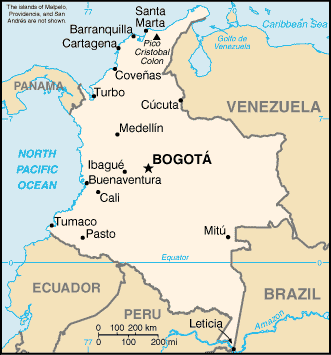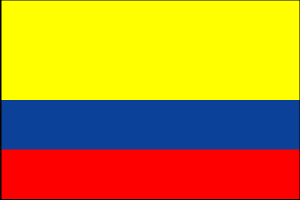
|
Colombia
Background:
Colombia was one of the three countries that emerged from the collapse of
Gran Colombia in 1830 (the others being Ecuador and Venezuela). A 40-year
insurgent campaign to overthrow the Colombian Government escalated during
the 1990s, under girded in part by funds from the drug trade. Although the
violence is deadly and large swaths of the countryside are under
guerrilla influence, the movement lacks the military strength or popular
support necessary to overthrow the government. An anti-insurgent army of
paramilitaries has grown to be several thousand strong in recent years,
challenging the insurgents for control of territory and illicit
industries such as the drug trade and the government's ability to exert
its dominion over rural areas.
Location:
Northern South America, bordering the Caribbean Sea, between Panama
and Venezuela, and bordering the North Pacific Ocean, between Ecuador
and Panama.
Area: Total: 1,138,910 sq km, land: 1,038,700 sq km.
Area - comparative: Slightly less than three times the size of Montana.
Land boundaries: Total: 6,004 km, border countries: Brazil 1,643 km,
Ecuador
590 km, Panama 225 km, Peru 1,496 km (est.), Venezuela 2,050 km.
Coastline: 3,208 km (Caribbean Sea 1,760 km, North Pacific Ocean 1,448
km).
Climate and Terrain:
Climate: Tropical along coast and eastern plains; cooler in highlands.
Terrain: Flat coastal lowlands, central highlands, high Andes
Mountains,
eastern lowland plains.
Natural resources: Petroleum,
natural gas, coal, iron ore, nickel, gold,
copper, emeralds, hydropower.
People:
Population: 41,008,227.
Ethnic groups: Mestizo 58%, white 20%, mulatto
14%, black 4%, mixed
black-Amerindian 3%, Amerindian 1%.
Religions: Roman Catholic 90%.
Languages: Spanish.
Government:
Government type: Republic; executive branch dominates government structure.
Capital: Bogota.
Independence: 20 July 1810 (from Spain).
Economy overview:
Colombia's economy suffered from weak domestic demand, austere
government
budgets, and a difficult security situation. A new president
takes office in
2002 and will face economic challenges ranging from
pension reform to reduction
of unemployment. Two of Colombia's leading
exports, oil and coffee, face an
uncertain future; new exploration is
needed to offset declining oil production,
while coffee harvests and
prices are depressed. Problems in public security are
a concern for
Colombian business leaders, who are calling for progress in
the
government's peace negotiations with insurgent groups.
GDP -
composition by sector: Agriculture: 19%, industry: 26%, services: 55%.
Statistics:
Telephones - main lines in use: 5,433,565.
Telephones - mobile
cellular: 1,800,229.
Radio broadcast stations: AM 454, FM
34.
Radios: 21 million.
Television broadcast
stations: 60.
Televisions: 4.59 million.
Internet
users: 878,000.
Railways: Total: 3,304 km.
Highways: Total: 110,000
km, paved: 26,000 km, unpaved: 84,000 km.
Airports: 1,066,
with
paved runways: 93,
with unpaved runways: 973,
Heliports: 1.
Return to Visiting Locations
|

